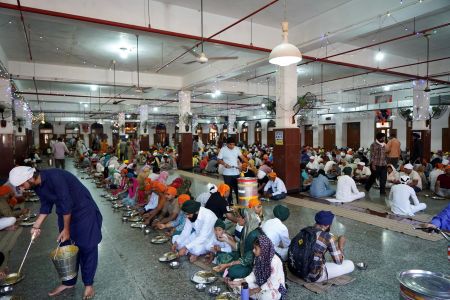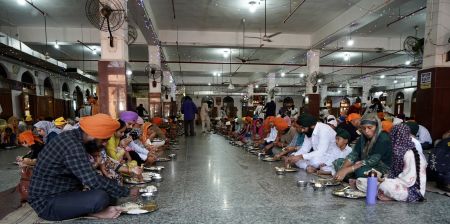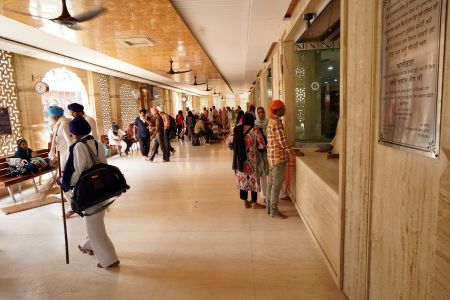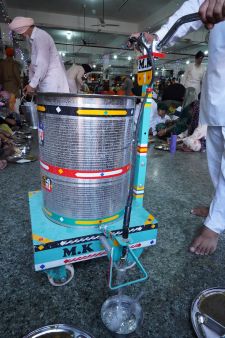A veteran journalist traces the miracle of the Sikh langar — an institution that has fed bodies and souls for centuries.
SOON AFTER I joined The Tribune at Chandigarh, there was an incident that left the entire Punjab shocked. A few children had died after eating the mid-day meal at a government school. It was a tragedy that could have been avoided if only the system had some sense of responsibility.
I wrote my first article for The Tribune using that incident as a peg. I asked a simple question: If the Sikh community can offer langar for centuries without a single case of food poisoning, why can’t the government serve safe, edible food to a few thousand children?

Equality — where a millionaire and a beggar may sit together and eat!
Every day, the Golden Temple in Amritsar feeds tens of thousands—three times a day—without fail. The kitchen never runs out of food, nor does it turn anyone away.
The food is simple but wholesome, prepared and served with love, devotion, and equality. I remember writing in that article that it wasn’t just about feeding the stomach—it was about nourishing the soul.
The response to the piece was overwhelming. Many readers wrote to say that they had taken the langar for granted, not realising what a miracle of organisation, discipline, and devotion it truly was.
The first time I heard about langar was in a very different context—while reading about the Vaikom Satyagraha in Kerala. The agitation, led by local reformers and supported by Mahatma Gandhi, was to secure the right of the so-called “low castes” to walk on a public road surrounding a temple. It had nothing to do with religion—it was a fight for human dignity.
During that struggle, Sikhs from Punjab came all the way to Vaikom to provide langar to the satyagrahis. They set up makeshift kitchens and served everyone, irrespective of caste, creed, or social status. The Sikhs’ presence was a living embodiment of their faith’s core teaching—sarbat da bhala, the welfare of all.

The langar at the Golden Temple — feeding tens of thousands every day.
Yet, Gandhi, mindful of Hindu sensitivities, requested them to return to Punjab. Some of them did—but not all. A few went southward and settled at Ranni, in Pathanamthitta district. There they married locally, converted a few, and formed a small but vibrant community.
They were beekeepers, and when I visited their village as a student of MS High School, Ranni, along with my elder sister—who had a “Sardarni” friend there—I was served honey in a cup for the first time in my life. As a child, I was fascinated by their appearance—their flowing beards, turbans, and long hair dripping after a bath.
Today, there isn’t a single Sikh left in that village. Years later, I did a story on them for The Tribune. It felt like closing a circle—the community that had once nourished others through langar had quietly dissolved into Kerala’s cultural soil.
The first time I actually had langar was much later, in Patna. Bishop Irenaeus Thirumeni of the Mar Thoma Church, later Joseph Marthoma, was visiting the city to resolve a local dispute and stayed with me for three days.
On the day of his departure, we had some time to spare before his flight, so we decided to visit the Patna Sahib Gurdwara—one of the holiest shrines of Sikhism, associated with Guru Gobind Singh, the tenth and the last.

Darbar Sahib — The Golden Temple, the spiritual heart of Sikhism.
When the granthi (the priest) learned that a bishop was visiting, he came running to meet us. The langar wasn’t ready, and we said we couldn’t stay long. But he wouldn’t hear of it. “How can you leave without sharing food with us?” he said.
Within minutes, hot puris were brought to us. We each took one and began eating there itself. Only then did the granthi allow us to go. It was an unforgettable moment—a small act of hospitality that carried centuries of tradition.
Over the years, I have eaten langar in many gurdwaras—Anandpur Sahib, Bathinda, Chandigarh, Tarn Taran—but none was as memorable as the one in Leh, Ladakh. I had gone there on assignment with a Tribune photographer. By the time we reached the gurdwara, the langar was over, and no restaurant was nearby.
When we told the granthi we were hungry, he disappeared for a few minutes and returned with a few charred rotis. Someone scraped the leftover dal from the bottom of a large vessel and gave it to us. We ate in silence. It was one of the tastiest meals I’ve ever had. Hunger and gratitude have a way of heightening the senses.

Joda Ghar — the ‘shoe house’ that accommodates lakhs of pairs every day.
On Friday last, our group decided to visit Harmandir Sahib—the Golden Temple—and partake of the langar there. Before entering, I had a tumbler of their famous tea—rich and slightly sweet—which almost killed my appetite. After a short wait, we were directed to a large hall where we sat cross-legged on the floor in neat rows.
That, to me, is the beauty of the langar. On your right may sit a multi-billionaire or a senior IAS officer; on your left, a daily wager or a homeless man. No one asks who you are or what you earn. All are served equally, and all eat together. The food becomes a great leveller—a silent declaration of equality.
A Sardarji seated beside me noticed that I was holding a camera. “Take my picture!” he said, smiling. I did, and when I showed it to him, he beamed with delight. When the rotis arrived, I instinctively received them the langar way—with both hands, palms open. That gesture itself carries meaning—it shows humility and readiness to accept what is given.

Innovation meets tradition — water dispenser used at the langar hall.
A new innovation caught my attention this time: a four-wheeled machine that dispenses water. One press of a button, and the right amount pours into your steel tumbler. My wife mistook the tumbler for a dal bowl, and soon it was filled with steaming dal! Two types of dal, roti, and rice formed the simple but delicious meal. Every morsel tasted of generosity.
When I first wrote about the langar in The Tribune, a reader from London wrote to me. He was a Sri Lankan who had gone there for his studies. Money was tight, he said, and most of his meals came from the local gurdwara. “Whenever I had time,” he wrote, “I would do some seva—cleaning or serving food. It was the least I could do.”
He said the langar not only filled his stomach but also kept alive his faith in human goodness. He remained eternally grateful to the Sikh community for, as he put it, “feeding my body and my soul.”

Seva in motion — devotees wash utensils together as an act of humility and service.
During my visits to Amritsar, I’ve often watched people competing to collect used plates and spoons for washing. These are not employees—they are volunteers, many of them wealthy or highly educated, who consider seva a blessing.
On another visit, I met a Sikh couple from the United States who had come to Amritsar just to do seva at the langar. Imagine that—people flying thousands of miles to wash utensils in a community kitchen!

Women devotees participate equally in seva at the Golden Temple.
No other community, I believe, has institutionalised compassion on such a scale. The langar is not a mere kitchen—it is a moral force. It sustains not just the hungry, but also the idea that all humans are equal before God.
I was in Chandigarh when the Golden Temple installed a machine that can make 10,000 rotis in an hour. Where else in the world are so many rotis consumed every day—not for profit or publicity, but as an act of faith?
From Vaikom to Leh, from Patna Sahib to the Golden Temple, the spirit of langar has followed me like a quiet teacher. It reminds me, every time I sit cross-legged on that marble floor, that the truest religion is service, and the purest offering is food shared in love. ![]()
All images courtesy: A. J. Philip
_________
Also Read:
Disclaimer : PunjabTodayNews.com and other platforms of the Punjab Today group strive to include views and opinions from across the entire spectrum, but by no means do we agree with everything we publish. Our efforts and editorial choices consistently underscore our authors’ right to the freedom of speech. However, it should be clear to all readers that individual authors are responsible for the information, ideas or opinions in their articles, and very often, these do not reflect the views of PunjabTodayNews.com or other platforms of the group. Punjab Today does not assume any responsibility or liability for the views of authors whose work appears here.
Punjab Today believes in serious, engaging, narrative journalism at a time when mainstream media houses seem to have given up on long-form writing and news television has blurred or altogether erased the lines between news and slapstick entertainment. We at Punjab Today believe that readers such as yourself appreciate cerebral journalism, and would like you to hold us against the best international industry standards. Brickbats are welcome even more than bouquets, though an occasional pat on the back is always encouraging. Good journalism can be a lifeline in these uncertain times worldwide. You can support us in myriad ways. To begin with, by spreading word about us and forwarding this reportage. Stay engaged.
— Team PT

